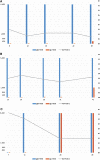First Laboratory-Confirmed Outbreak of Human and Animal Rift Valley Fever Virus in Uganda in 48 Years
- PMID: 30675833
- PMCID: PMC6402942
- DOI: 10.4269/ajtmh.18-0732
First Laboratory-Confirmed Outbreak of Human and Animal Rift Valley Fever Virus in Uganda in 48 Years
Abstract
In March 2016, an outbreak of Rift Valley fever (RVF) was identified in Kabale district, southwestern Uganda. A comprehensive outbreak investigation was initiated, including human, livestock, and mosquito vector investigations. Overall, four cases of acute, nonfatal human disease were identified, three by RVF virus (RVFV) reverse transcriptase polymerase chain reaction (RT-PCR), and one by IgM and IgG serology. Investigations of cattle, sheep, and goat samples from homes and villages of confirmed and probable RVF cases and the Kabale central abattoir found that eight of 83 (10%) animals were positive for RVFV by IgG serology; one goat from the home of a confirmed case tested positive by RT-PCR. Whole genome sequencing from three clinical specimens was performed and phylogenetic analysis inferred the relatedness of 2016 RVFV with the 2006-2007 Kenya-2 clade, suggesting previous introduction of RVFV into southwestern Uganda. An entomological survey identified three of 298 pools (1%) of Aedes and Coquillettidia species that were RVFV positive by RT-PCR. This was the first identification of RVFV in Uganda in 48 years and the 10th independent viral hemorrhagic fever outbreak to be confirmed in Uganda since 2010.
Figures



References
-
- Elliott RM, Schmaljohn CS, 2013. Bunyaviridae. Fields Virology, Vol. 1, 6th edition Philadelphia, PA: Lippincott Williams and Wilkins, 1245–1278.
-
- Bird BH, Ksiazek TG, Nichol ST, Maclachlan NJ, 2009. Rift Valley fever virus. J Am Vet Med Assoc 234: 883–893. - PubMed
-
- WHO , 2017. WHO Rift Valley Fever Fact Sheet. Geneva, Switzerland: World Health Organization.
Publication types
MeSH terms
Substances
LinkOut - more resources
Full Text Sources

